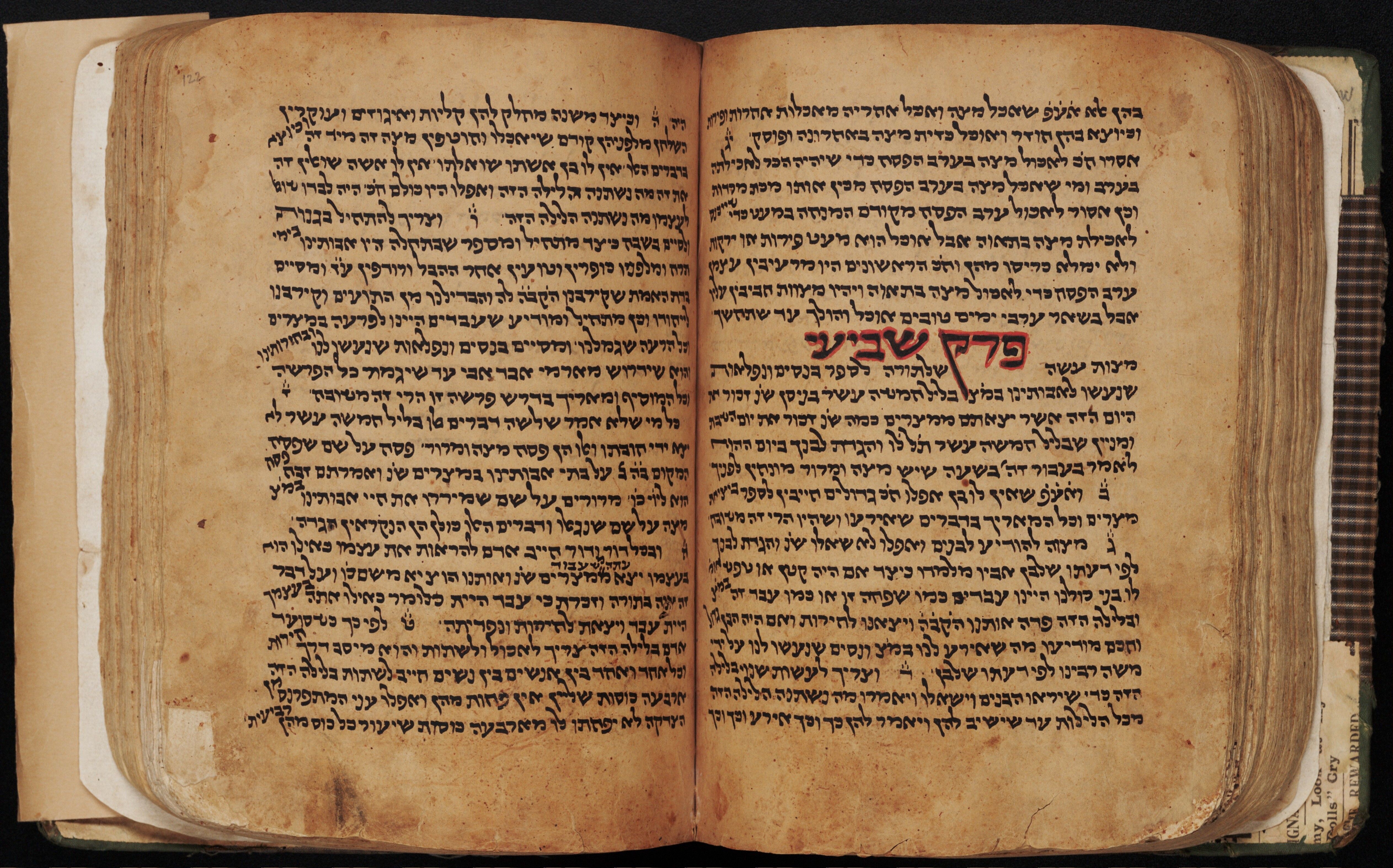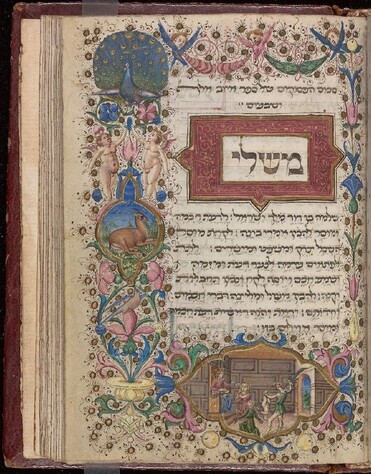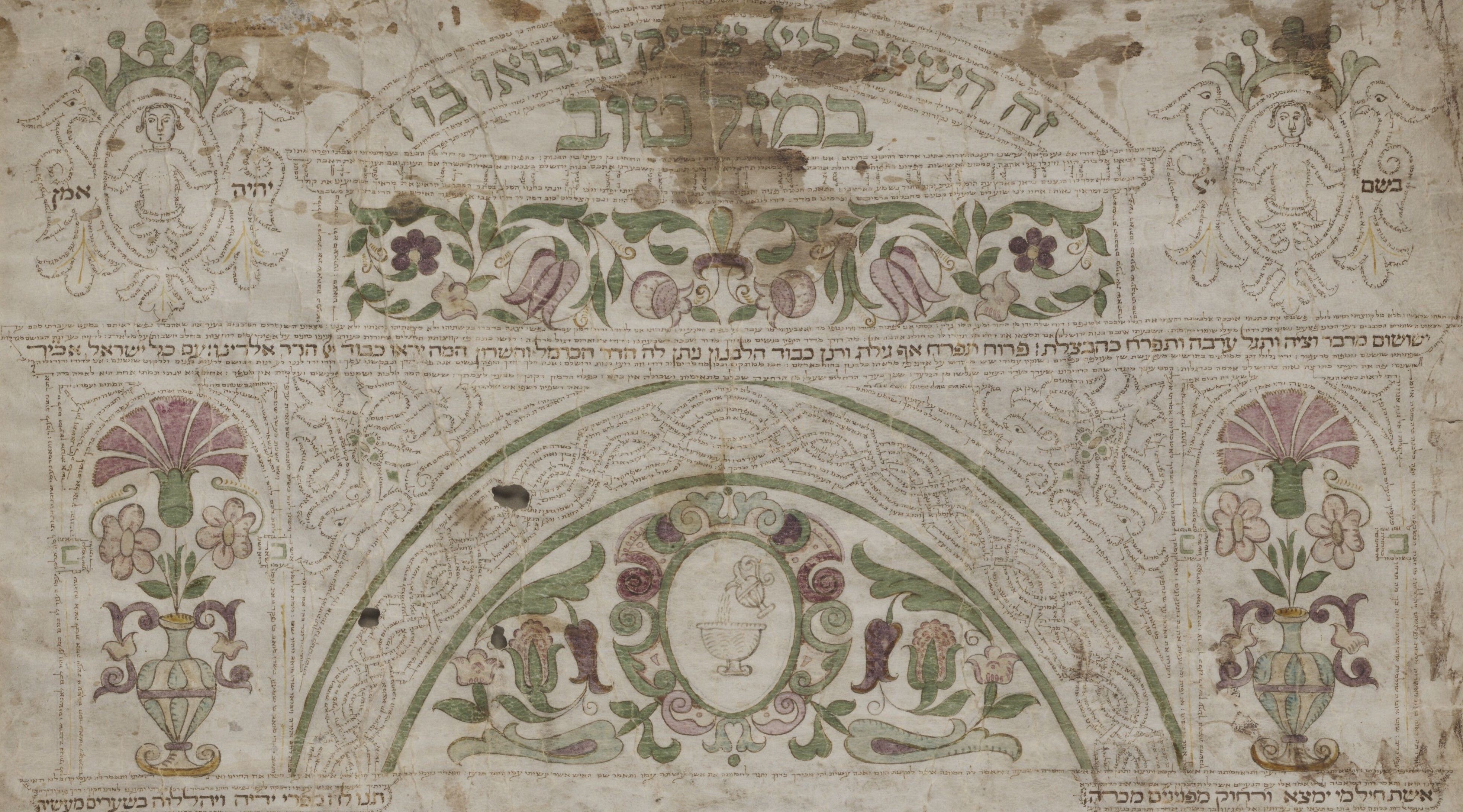Detail, Hebrew +97. Ketubah. Italy, 1662.
The making of Hebrew books and manuscripts is a well established and storied tradition. From scrolls to codicies and the heavily illuminated to the tidy and minimalistic, these objects contain scientific texts, biblical materials, legal and religious treatises, and stand as witnesses to a language used across geographic regions.
While some elements of these manuscripts and early books share features with contemporary non-Hebrew objects, they also display unique characteristics. In the above detail from an Italian Ketubah or marriage contract (Hebrew +97), the use of micrography or tiny letter forms or words to create an interlace pattern upon the arch and the columns. This particular practice of intertwining text and image is an art unique to Hebrew manuscripts.

Hebrew MS 1. Mishneh Torah. Maimonides. Yemen, 1386 CE.
As the Beinecke Library catalogue indicates, this fourteenth century manuscript features,”caligraphic Yemenite square characters.” One of the wonderful features of the study of paleography (literally, “old writing”) is an ability to assist in localizing a manuscript and identifying what cultural context in which a text may have been copied. While many of the Hebrew early books and manuscripts in the Beinecke were copied or printed in Europe, the collection also contains witnesses to a manuscript culture that is much more geographically expansive. This text, the Mishneh Torah written by Maimonides (1138-1204), is a book of Jewish law. The work of Maimonides has had a long life, continuing to be of value into the twenty-first century.

Beinecke MS 409. Psalms. 1467, Italy.
This beautiful medieval psalter boasts truly incredible illuminations. With two full page miniatures and a proliferation of floral borders, this volume is truly a luxury book! On page above, puti, birds, and blooming flowers all inhabit the richly decorated margin. Along the bottom, encircled by a gold border, a famous tale of King Solomon plays out. Seated upon a throne, the crowned king mediates a dispute between two women. The women have come to him, both insisting that this one infant is their own child. Solomon, gesturing toward one of his guards, orders that the child be physically divided between the two— an act that would surely kill the infant. Horrified by this, the real mother relents and offers to rescind her claims if the child would be allowed to live. Seeing her willingness to protect the life of the infant, Solomon stops the guard from harming the child and awards the baby to the correct mother. This iconic scene, captured at the pivotal moment of intercession, prompts the reader to recall both true motherly devotion and evidence of Solomon’s wisdom.

Detail, Hebrew +93:17. Esther Scroll. Austrian Poland, 1750 (?).
The borders of this early modern Esther scroll are full of life. Figures in yellow, green, and red, act out the story of Esther across the top and the bottom of the scroll. As noted in the catalog entry, these figures are differentiated by dress: caftans are worn by the Jewish characters and “18th century Polish-Austrian costumes” by those associated with the antagonist, Haman. Decorated Esther scrolls, a genre unique to the Jewish tradition, were designed to be read aloud during Purim. Their form— a scroll, rather than a codex— refects the Hebrew name for the Book of Esther: the Megilat Ester (מגילת אסתר) or literally, the scroll of Esther. This particular manuscript is bookended by blessings to be read before and after the main text.

Hebrew +32. Haggadah shel Pesah. 1726.
While it may appear to be printed at first glance, this eighteenth century Haggadah shel Pesah is a manuscript— a fact given away by the ink itself. Used during the celebration of Passover, the Haggadah contains texts intended to be read aloud at Seder. As per our catalog, some of the miniatures, like those featured here, are actually based upon the printed 1712 Amsterdam Haggadah. In the above opening, two miniatures illustrate scenes from Exodus. On the left, Moses gestures with his staff, as the pharaoh in his chariot and his troops are swallowed up by the Red Sea. Opposite this, a distant Moses receives the commandments from God, his outstretched arms holding aloft the two stone tablets.
More on Information on the Collection at Yale
Yale University Library Judaic Studies Resources Guide
Beinecke Highlights: The Art of the Ketubah
Further Resources
The Polonsky Foundation Catalogue of Digitised Hebrew Manuscripts at the British Library
The Columbia University Collection of Hebraica and Judaica
University of Cambridge, Cambridge Digital Library, Hebrew Manuscripts
University of Cambridge, Cairo Genizah
Binyamin Richler. Guide to Hebrew Manuscript Collections. Jerusalem: Israel Academy of Sciences and Humanities, 2014.
Stefan C. Reif. Problems with Prayers: Studies in the Textual History of Early Rabbinic Liturgy. Berlin, New York: W. de Gruter, 2006.
Stefan C. Reif. Jewish Prayer Texts from the Cairo Genizah: A Selection Manuscripts at Cambridge University Library, Introduced, Transcribed, and Annotated, with Images. Leiden, Boston: Brill, 2016.
Colette Sirat. Hebrew Manuscripts of the Middle Ages. Cambridge; New York : Cambridge University Press, 2002.
Ilana Tahan. Hebrew Manuscripts: The Power of Script and Image. London: British Library, 2007.
Piet van Boxel and Sabine Arndt, editors. Crossing Borders: Hebrew Manuscripts as a Meeting-Place of Cultures. Oxford: Bodleian Library, 2009.
Joseph R. Hacker and Adam Shear, editors. The Hebrew Book in Early Modern Italy. Philadelphia: University of Pennsylvania Press, 2011.
Marvin J. Heller. Studies in the Making of the Early Hebrew Book. Leiden; Boston: Brill, 2008.
Marvin J. Heller. Further Studies in the Making of the Early Hebrew Book. Leiden; Boston: Brill, 2013.
